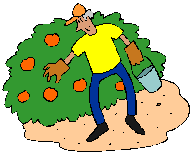
How to Make Pickle Relish - Easily! With step by step photos, recipe ingredients and costs
Making Homemade Pickle Relish
Click here for a PDF print version
Making and canning your own pickle relish is one of the easiest things you can do with your extra cucumbers! Here's how to do it, in easy steps and completely illustrated. This method is so easy, ANYONE can do this! It's a great thing to do with your kids!
Note: More photos are coming
Ingredients
Yield: About 8 pints
- About 6 lbs of pickling type cucumbers to yield 3 quarts chopped cucumbers
- About 6 large peppers to produce 3 cups each of chopped sweet green and red peppers
- 2 onions (to yield 1 cup chopped onions)
- 3/4 cup canning or pickling salt
- 4 cups ice
- 8 cups water
- 2 cups sugar
- 4 tsp each of mustard seed, turmeric, whole allspice, and whole cloves See this page for pickling supplies, equipment, books, crocks and additives.
- 6 cups white vinegar (5%, apple cider vinegar works well. Store brand is about $1.25 for a 64 oz bottle.
Equipment
- Jar grabber (to pick up the hot jars)
- Lid lifter (I like the lid rack that holds 12 lids or you can pull them out one at a time with the lid-lifter that has a magnet from the almost-boiling water where you sanitize them. ($4 at Target, other big box stores, and often grocery stores; and available online - see this page)
- Jar funnel ($5 at Target, other big box stores, and often grocery stores; and available online - see this page)
- 1 large pots; Nonstick ceramic coated pots for easy cleanup.
- Large spoons and ladles,
- 1 water bath canner (a huge pot to sanitize the jars after filling (about $30 to $35 at mall kitchen stores, sometimes at big box stores and grocery stores.). Note: we sell many sizes and types of canners for all types of stoves and needs - see canning supplies
- Half pint canning jars or pint canning jars (Ball or Kerr jars can be found at grocery stores, like Safeway, Publix, Kroger, grocery stores, even online - about $13 per dozen 8-ounce jars, more for quilted design or larger jars, including the lids and rings). Be sure to get wide mouth jars to fit the pickles in! Pint size works best!
- Lids - thin, flat, round metal lids with a gum binder that seals them against the top of the jar. They may only be used once.
- Rings - metal bands that secure the lids to the jars. They may be reused many times.
Directions - How to Make Pickle Relish
DAY 1
Step 1 - Selecting the cucumbers
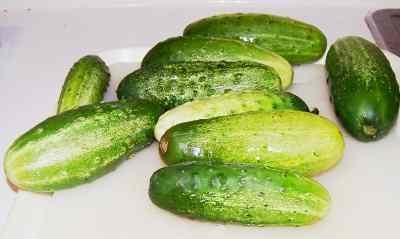 It's
fun to go pick your own and you can obviously get better quality
cucumbers!
It's
fun to go pick your own and you can obviously get better quality
cucumbers!
At right is a of picture cucumbers from my garden - they are SO easy to grow. But be sure to grow the varieties that are labeled "pickling cucumbers" - they will be much more crisp!
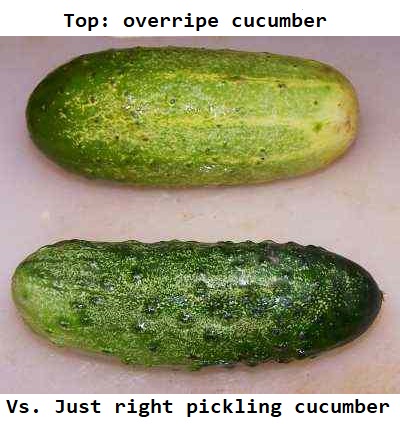 The
picture at right shows a good cucumber for pickling (bottom) and a bad one
(top). The good one is dark green, firm, and not bloated. It has
lots of warts!
The
picture at right shows a good cucumber for pickling (bottom) and a bad one
(top). The good one is dark green, firm, and not bloated. It has
lots of warts!
The bad one is overripe, it has yellow or white areas in the skin, and the warts are almost all gone. If you cut it open, you will see developed seeds. You don't want seeds!
Overripe cucumbers make mushy relish..
Step 2 - How many cucumbers?
It takes about 2 or 3 cucumbers per pint jar; figure about 6 pounds to make about 7 pints. Each cucumber is about 4 - 5 inches long and you will cut off the ends before chopping.
Step 3 -Wash and chop the vegetables!
I'm sure you can figure out how to wash the fruit in plain cold water.
You will need to cut the ends off (about 1/4-inch) and chop them into 1/8 to 1/4-inch pieces - or however finely you like your relish!
Chop 6 large peppers to produce 3 cups each of chopped sweet green and red peppers.
Chop 2 onions to yield 1 cup chopped onions.
Step 4 - Soak the chopped vegetables
In a large bowl, combine the
- 3 quarts chopped cucumbers
- 3 cups each of chopped sweet green and red peppers
- 1 cup chopped onions)
- 3/4 cup canning or pickling salt
- 2 cups ice
- 4 cups water
and let stand for 4 hours. Use more of each water and ice, if needed to cover the veggies
Step 5 - Drain
Just drain and discard the salt water.
Step 6 - Cover the vegetables with fresh ice water for another hour.
Cover the chopped veggies with 2 cups of ice and 4 cups of water (use more of each, if needed to cover) and let it stand for 1 hour more.
Step 7 - Drain again.
Just drain and discard the water again.
Step 8 - Mix the spices and vinegar
Combine the 4 teaspoons each of mustard seed, turmeric, whole allspice, and whole cloves in a spice or cheesecloth bag. Add spices to 2 cups sugar and 6 cups white vinegar .
Step 9 - Heat the spice/vinegar mix to a boil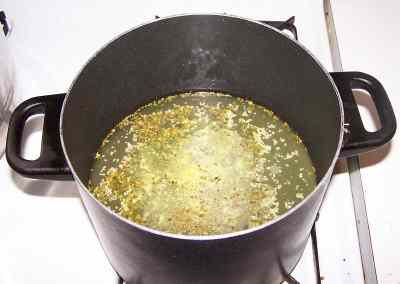
Heat to the vinegar and spice mix to a boil.
Step 10 - Pour the spice/vinegar over the chopped vegetables
Pour the spice/vinegar over the chopped vegetables and then cover and refrigerate for 24 hours, (up to 36 hours).
DAY 2
Step 11 - Get the jars and lids sanitizing
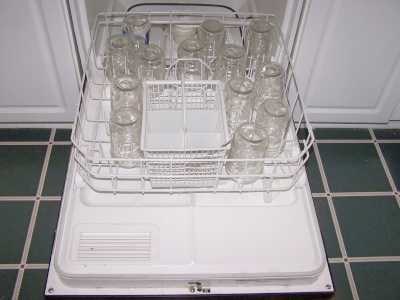
The dishwasher is fine for the jars; especially if it has a "sanitize"
cycle. I get that going while I'm preparing everything else, so it's
done by the time I'm ready to fill the jars. If you don't have a
dishwasher, submerge the jars in a large pot (the canner itself) of water
and bring it to a boil.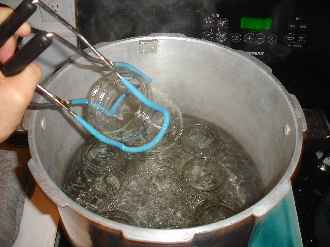
Be sure to let it go through the rinse cycle to get rid of any soap!
Get the canner heating up
Fill the canner about 1/2 full of water and start it heating (with the lid on).
Start the water for the lids
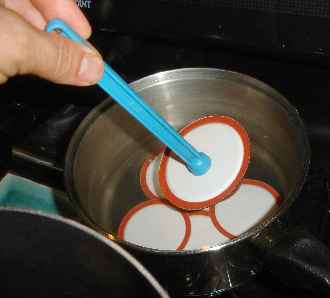 Put
the lids into a pan of hot, but not quite boiling water for at least several minutes.
Note: everything gets sanitized in the water bath (step 7) anyway, so this just
helps to ensure there is no spoilage later!)
Put
the lids into a pan of hot, but not quite boiling water for at least several minutes.
Note: everything gets sanitized in the water bath (step 7) anyway, so this just
helps to ensure there is no spoilage later!)
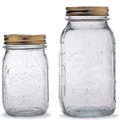

 Need
lids, rings and replacement jars?
Need
lids, rings and replacement jars?
Get them all here, delivered direct to your home, at the best prices on the internet!
Step 12 - Heat the relish for canning
Remove the bag of spices. Heat the relish to boiling, stirring as necessary to prevent burning. If you like a thicker relish, simmer a bit longer (another 15 minutes) to gently boil off some of the water.
Step 13 - Fill the jars with relish and put the lid and rings on
Fill the pint or half pint jars with the relish to within 1/4 to 1/2 inch of the top, seat the lid and hand-tighten the ring around them. (Note: larger jars are not recommended.)
Step 14 - Boil the jars in the canner
 Put
them in the canner and keep them covered with at least 1 inch of water.
Keep the water boiling. Boil them for 10 minutes (or as directed by the
instructions in the pickle mix, or with your canner).
Remember to adjust for altitudes and
larger jars!
Put
them in the canner and keep them covered with at least 1 inch of water.
Keep the water boiling. Boil them for 10 minutes (or as directed by the
instructions in the pickle mix, or with your canner).
Remember to adjust for altitudes and
larger jars!
| Recommended process time for Pickle Relish in a boiling-water canner | ||
| Process Time at Altitudes of | ||
| 0 - 1,000 ft | 1,001 - 6,000 ft | Above 6,000 ft |
| 10 min | 15 min | 20 min |
Step 15 - Done
Lift the jars out of the water and let them cool without touching or bumping them in a draft-free place (usually takes overnight) You can then remove the rings if you like, but if you leave them on, at least loosen them quite a bit, so they don't rust in place due to trapped moisture. Once the jars are cool, you can check that they are sealed verifying that the lid has been sucked down. Just press in the center, gently, with your finger. If it pops up and down (often making a popping sound), it is not sealed. If you put the jar in the refrigerator right away, you can still use it. Some people replace the lid and reprocess the jar, then that's a bit iffy. If you heat the contents back up, re-jar them (with a new lid) and the full time in the canner, it's usually ok.
When can you start eating the relish? As son as the jars cool!
How long will they keep in cool, dark storage? Usually 12 to 18 months!
Summary - Cost of Making Homemade Pickles - makes 8 pint jars, 16 oz each* |
||||
| Item | Quantity | Cost in 2025 | Source | Subtotal |
| Cucumbers | 30-36 (about 3 per pint jar) | free from the garden, or $3.00 cents at a PYO | Pick your own | $3.00 |
| Canning jars (pint size, wide mouth), includes lids and rings | 8 jars | $8.00/dozen | Grocery stores (Publix, Kroger, Safeway, etc.) | $5.35 |
| Vinegar | 6 cups | $1.20 | Safeway, Publix, Kroger, grocery stores |
$1.20 |
| Sugar | 2 cups | $0.50 per pound, 1 lb is about 2 cups | Safeway, Publix, Kroger, grocery stores |
$0.50 |
| Spices | 4 teaspoons each | $3.00 per package | Grocery stores (Publix, Kroger, Safeway, etc.) | $3.00 |
| Onion | 2 | $0.50 each | Safeway, Publix, Kroger, grocery stores |
$1.00 |
| Pickling Salt | 3/4 cup | $3.00 per 3 cup box | Safeway, Publix, Kroger, grocery stores |
$0.80 |
| Total | $14.85 total or about $1.86 per jar INCLUDING the jars - which you can reuse! |
|||
|
* - This assumes you already have the pots, pans, ladles,, and reusable equipment. Note that you can reuse the jars! Many products are sold in jars that will take the lids and rings for canning. For example, Classico Spaghetti sauce is in quart sized jars that work with Ball and Kerr lids and rings. Note that the Classico's manufacturer does not recommend reuse of their jars: see what they have to say on this page: |
||||
How to make other pickles - recipes and instructions:
- Cucumber pickles (quick process, canned)
- Refrigerator pickles (no canning required)
- Pickled beets
- Pickled green beans
- Pickled dilled okra
Canning processing times
|
Type of pickling method |
Jar size | 0 to 1,000 ft above sea level | 1,001 to 6,000 ft above sea level |
| Quick process, (raw cucumbers put in the jar, hot liquid poured over them)- | pint | 10 min | 15 min |
| Quick process, (raw cucumbers put in the jar, hot liquid poured over them)- | quart | 10 min | 15 min |
Can't find the equipment? We ship to all 50 states! Use our Feedback form!
Answers to Common Questions
Pickle Making Problems? Pickling FAQs Frequently asked questions and answers
What did I do wrong if my pickles aren't crisp or
crunchy?
You probably used overripe cucumbers or didn't measure the vinegar and water
accurately. Of course, processin gtoo long in the boiling water bath can do it,
too!
Why are my pickles cloudy?
There are a variety of possible causes for cloudy pickles:
In nonfermented pickles (fresh pack), cloudiness might indicate spoilage. Yeast growth may also make pickles cloudy or slimy. Check the pickles for signs of off-odors and mushiness of the pickles. If yeast growth is evident, discard the pickles. If these signs are absent, the pickles are (absent other problems) safe to eat.
Be sure to use a NON-metal pot - or a coated metal (teflon, silverstone, enamel, etc.) without breaks in the coating. the metal reacts with the vinegar and makes the pickle solution turn cloudy. This is the most common cause of cloudy pickles. There is no danger to these pickles, though!
Sometimes the fillers (anticaking agents) in regular table salt may cause slight cloudiness, so always use pickling salt. Obviously, if you used a packet mix (like Mrs. Wages) this should not be a problem.
Hard water might also cause cloudiness. If soft water is not available, boil the hard water and let it sit undisturbed overnight. Pour off the top portion and use it in the pickling solution.
When making quick process pickles, can I store any leftover pickling solution for future use?
If the pickling solution is fresh and has not been used to make pickles, cover it and store it in the refrigerator for later use. If the pickling solution has been used, it can be stored in the refrigerator and reused in a day or two for barbecue sauce, cole slaw dressing or a marinade. If mold growth occurs, throw it out.
Why did the liquid in my dill pickles turn pink?
Using overmature dill may cause this. If so, the product is still safe. However, yeast growth could also cause this. If yeast growth is evident, discard the pickles.
I don't have the type of dill my recipe calls for. What can I substitute?
For each quart, try 3 heads of fresh dill or 1 to 2 tablespoons dill seed (dill weed = 2 tablespoons).
Can I use burpless cucumbers for pickling?
Burpless cucumbers are not recommended for use in fermented pickles. This is because at their normal mature size, they produce an enzyme that causes the pickles to soften during fermentation. However, if smaller burpless cucumbers (those with small seed) are used, they may be suitable for making fresh pack pickles.
I have an old recipe that calls for adding a grape leaf to each jar of pickles. Why?
Grape leaves contain a substance that inhibits enzymes that make pickles soft. However, if you remove the blossom end of the cucumbers (the source of undesirable enzymes) you don't need to add grape leaves.
Why did the garlic cloves in my pickles turn green or bluish green?
This reaction may be due to iron, tin or aluminum in your cooking pot, water or water pipes reacting with the pigments in the garlic. Or, the garlic may naturally have more bluish pigment, and it is more evident after pickling. Immature bulbs should be cured two to four weeks at 70 ° F. The pickles are safe to eat.
Can I use flaked salt for pickling?
Most recipes call for granulated pickling or canning salt. Flake salt varies in density and is not recommended for pickling.
Can I safely substitute ingredients in a recipe?
I'm checking out your relish recipe, and I'm looking at many different hot pickle recipes on the web and canning info (I've never done this before, but we bought a water-bath canning kit last year). A lot of canning info says never to alter the proportions in the recipe, but I can't find one with the proportions of hot peppers to cucumbers that I want.
Could I take your relish recipe and add jalapenos or other hot peppers to make a spicy relish, or would it cause it to become unsafe because I'm altering the ratio of vegetables? Could I decrease the amount of jalapenos in a different pickle recipe (it was almost as many peppers as cucumbers, and I don't have that) and still be safe? I don't want to go through all this work and then have the stuff get us sick or be inedible. But I can't find a recipe that I like that's not flake pepper or one that uses garden peppers and a bunch of other ingredients that I don't have (other vegetables, alum... )
I guess I don't know what you can modify in a canning recipe and what you can't, and I don't want to do it wrong. And I don't have anyone to ask, because I didn't want to learn this while my aunties were still alive.
A. The short answer is no, you shouldn't change the proportions or use different ingredients
The reason the recipes say not to alter the proportions of ingredients is that may affect the pH or total acidity of the mix. The recipes (at least those on my website and the ones published by universities - were tested in laboratories with those exact proportions. They cultured the resulted and examined them to determine if there was any pathogenic activity.
By the way, don't assume that every canning recipe published in a book or online has been tested or is based on a lab tested recipe. Many are not! My recipes are based on the ones tested and published by the USDA, Ball, and the major university food science departments. For the most part, I merely took the USDA recipes, executed them verbatim, photographed the process and added more explanatory text to make them easier to follow.If you change a recipe substantially, it will affect the ability of pathogens like harmful bacteria to survive after canning.The word key is "substantially". If you replace 1 cup of blackberries in a recipe with 1 cup of raspberries, is that risky? Almost certainly not. One need not be a food scientist to know those too are closely related and probably have nearly identical properties.But what about adding 1 cup of onions to a spaghetti sauce recipe? Or peppers to a relish? That's hard to say. You will be hard pressed to find anyone who would want to go on record to say it's ok, lest someone get sick later!Also, if you want to improve the safety of almost any canning, replace the water bath with a Pressure Canner. Pressure canners produce a substantially higher temperature, which kills a high percentage of a greater variety of pathogens than water bath canners.I think it's generally safe to replace like with like; hot peppers to replace green peppers, raspberries instead of blackberries, lemons instead of limes, etc. So, in your case, I think you will be fine if you substitute some of the mild peppers with an equal amount of hot peppers!
Picking Tips
[General picking tips and a guide to each fruit and vegetable] [How much do I need to pick? (Yields - how much raw makes how much cooked or frozen)] [Selecting the right varieties to pick] [All about apple varieties - which to pic
k and why!] [Picking tips for Vegetables]
[ Strawberry picking tips]
[ Blueberries picking tips]

Canning Books, Supplies and Accessories
These are my favorite essential canning tools, books and supplies. I've been using many of these for over 50 years of canning! The ones below on this page are just the sampling of. my preferred tools. but you can find much more detailed and extensive selections on the pages that are linked below.
- Vacuum Foodsealers for freezing, dried foods, and refrigerated foods - the FoodSaver line
- Selecting a KitchenAid mixer and attachments for home canning
- Steam Juicers
- Strainers, pit removers, seed-skin-stem removers, jelly strainers, etc. All types, makes and prices (from $19 to $350)
- Cherry pitters reviews, prices and ordering
- Food dehydrators - easy and fast to dry your own fruits, veggies, sun-dried tomatoes, etc.
The All New Ball Book Of Canning And Preserving: Over 350 of the Best Canned, Jammed, Pickled, and Preserved Recipes Paperback
This is THE book on canning! My grandmother used this book when I was a child.; It tells you in simple instructions how to can almost anything; complete with recipes for jam, jellies, pickles, sauces, canning vegetables, meats, etc.
If it can be canned, this book likely tells you how! Click on the link below for more information and / or to buy (no obligation to buy)The New Ball Blue Book of Canning and Preserving
Canning and Preserving for Dummies by Karen Ward
This is another popular canning book. Click here for more information, reviews, prices for Canning and Preserving For Dummies
Of course, you do not need to buy ANY canning book as I have about 500 canning, freezing, dehydrating and more recipes all online for free, just see Easy Home Canning Directions.
Home Canning Kits
See here for related tools, equipment, supplies on Amazon See here for related tools, equipment, supplies on Amazon
I have several canners, and my favorite is the stainless steel one at right. It is easy to clean and seems like it will last forever. Mine is 10 years old and looks like new.
The black ones are the same type of standard canner that my grandmother used to make everything from applesauce to jams and jellies to tomato and spaghetti sauce.
This complete kit includes everything you need and lasts for years: the canner, jar rack, Jar grabber tongs, lid lifting wand, a plastic funnel, labels, bubble freer, It's much cheaper than buying the items separately. It's only missing the bible of canning, the Ball Blue Book.
You will never need anything else except jars & lids (and the jars are reusable)!
The complete list of canners is on these pages:
- Water bath canners - Good for acidic foods, like applesauce, pickles, salsa, jams, jellies, most fruits
- Pressure canners - needed for low and non-acidic foods, like canned vegetables (corn, green beans, etc), and meats
- Canners for glass top stoves if you have a glass or ceramic stove
- Canners for induction stovetops
Pressure Canners
If you plan on canning non-acidic foods and low acid foods that are not pickled - this means: meats, seafood, soups, green beans corn, most vegetables, etc., then you ABSOLUTELY must use a Pressure Canner.
Of course, you can use a pressure canner as a water bath canner as well - just don't seal it up, so it does not pressurize. This means a Pressure Canner is a 2-in-1 device. With it, you can can almost ANYTHING.
There are also other supplies, accessories, tools and more canners, of different styles, makes and prices, click here!
Basic Canning Accessories
From left to right:
- Jar lifting tongs to pick up hot jars
- Lid lifter - to remove lids from the pot of boiling water (sterilizing )
- Lids- disposable - you may only use them once
- Ring - holds the lids on the jar until after the jars cool - then you remove them, save them and reuse them
- Canning Jar funnel - to fill the jars
FREE Illustrated Canning, Freezing, Jam Instructions and Recipes
Don't spend money on books. that you don't need to. Almost everything you can find in some book sold online or in a store is on my website here for free. Start with theEasy Home Canning Directions below. That is a master list of canning directions which are all based upon the Ball Bblue book, the National Center for Home Food Preservation and other reputable lab tested recipes. Almost every recipe I present in addition to being lab tested com. is in a step by step format with photos for each step and complete. explanations. that tell you how to do it, where to get the supplies and pretty much everything you need to know. In addition, there almost always in a PDF format so you can print them out and use them while you cook.
[ Easy Home Canning Directions]
[FAQs - Answers to common questions and problems]
[Recommended books about home canning, jam making, drying and preserving!]
Looking for canning equipment and supplies?
Water bath canner with a jar rack
Pressure canners for gas, electric and induction stoves: Presto 23Qt or T-fal 22Qt
Canning scoop (this one is PERFECT)
Ball Blue book (most recent version)
Jars: 8oz canning jars for jams
Find Other types of farms:
Farm markets and roadside stands
Road trips and camping resources
Local Honey, apiaries, beekeepers
Consumer fraud and scams information
Home canning supplies at the best prices on the internet!
Maple Syrup Farms, sugarworks, maple syrup festivals
Environmental information and resources
Farms For Your Event for birthday parties, weddings, receptions, business meetings, retreats, etc.
Festivals - local fruit and vegetable festivals
Get the
most recent version of
the Ball Blue Book
With this Presto 23 quart pressure canner and pressure cooker, you can "can" everything, fruits, vegetables, jams, jellies, salsa, applesauce, pickles, even meats, soups, stews. Model 01781

You can make jams, jellies, can fruit, applesauce, salsa and pickles with water bath canners, like this Granite Ware 12-Piece Canner Kit, Jar Rack, Blancher, Colander and 5 piece Canning Tool Set



